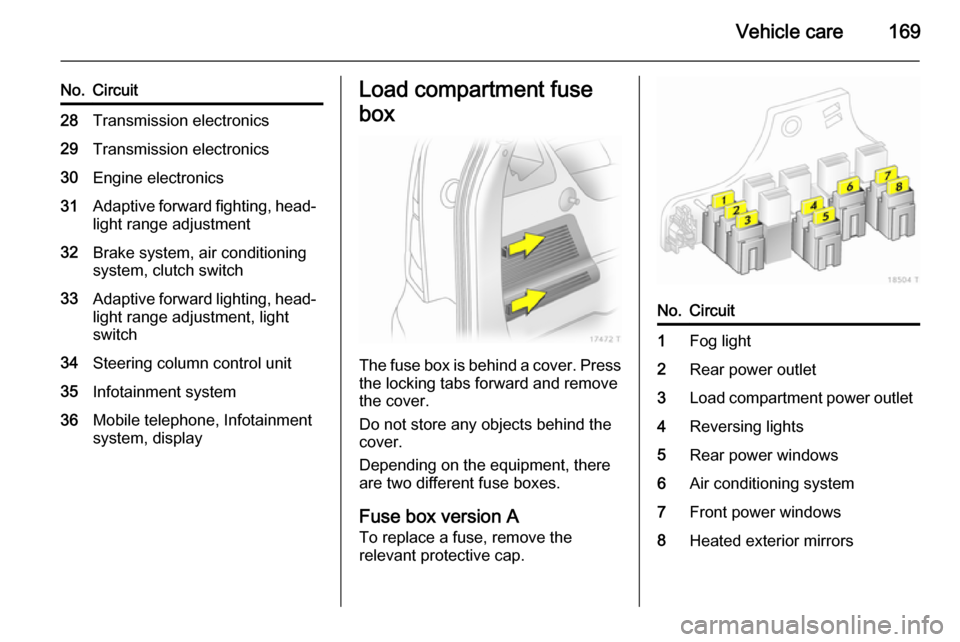power steering VAUXHALL ZAFIRA 2014 Owner's Manual
[x] Cancel search | Manufacturer: VAUXHALL, Model Year: 2014, Model line: ZAFIRA, Model: VAUXHALL ZAFIRA 2014Pages: 217, PDF Size: 7.85 MB
Page 30 of 217

28Keys, doors and windows
Radio remote controlsynchronisation
After replacing the battery, unlock the
door with the key in the driver's door
lock. The radio remote control will be
synchronised when you switch on the
ignition.
Memorised settings Whenever the vehicle is locked the
last settings are automatically saved
specifically for the used key:
■ Electronic climate control,
■ Info-Display,
■ Infotainment system,
■ Instrument panel illumination.
The saved settings are automatically used next time that key is used for
unlocking.Open&Start system
Makes operation of the following
possible without the use of the
mechanical key
■ Central locking system,
■ Anti-theft locking system,
■ Anti-theft alarm system,
■ Power windows,
■ Ignition and starter.
The electronic key simply needs to be in the driver's possession.
Press the Start/Stop button. The
ignition is switched on. The
immobiliser and steering wheel lock
are deactivated.
To start the engine press and hold the
Start/Stop button whilst applying both
the brake and clutch pedals.
Automatic transmission: the engine
can only be started with the selector
lever in P or N.
The engine and the ignition are
switched off by pressing the Start/
Stop button again. The vehicle must
be stationary. The immobiliser is
activated at the same time.
Page 126 of 217

124Driving and operatingDriving and operatingDriving hints............................... 124
Starting and operating ...............124
Engine exhaust .......................... 127
Automatic transmission .............. 128
Manual transmission ..................133
Manual transmission automa‐
ted .............................................. 134
Brakes ........................................ 138
Ride control systems .................139
Cruise control ............................. 141
Object detection systems ........... 142
Fuel ............................................ 144
Trailer hitch ................................ 146Driving hints
Control of the vehicleNever coast with engine not
running
Many systems will not function in this
situation (e.g. brake servo unit, power
steering). Driving in this manner is a
danger to yourself and others.
Pedals To ensure the pedal travel is
uninhibited, there must be no mats in
the area of the pedals.Starting and operating
New vehicle running-in Do not brake unnecessarily hard for
the first few journeys.
During the first drive, smoke may
occur because of wax and oil
evaporating off the exhaust system.
Park the vehicle in the open for a
while after the first drive and avoid
inhaling the fumes.
During the running-in period fuel and
engine oil consumption may be
higher and the cleaning process of the diesel particle filter may take
place more often. Diesel particle filter 3 127.
Page 149 of 217

Driving and operating147
For trailers with low driving stability
and trailers with a permitted gross
vehicle weight of more than 1300 kg a speed of 50 mph must not be
exceeded; the use of a stabiliser is
recommended.
If the trailer starts snaking, drive more slowly, do not attempt to correct the
steering and brake sharply if
necessary.
When driving downhill, drive in the
same gear as if driving uphill and
drive at a similar speed.
Adjust tyre pressure to the value
specified for full load 3 205.
Trailer towing Trailer loads
The permissible trailer loads are
vehicle and engine-dependent
maximum values which must not be
exceeded. The actual trailer load is
the difference between the actual
gross weight of the trailer and the
actual coupling socket load with the
trailer coupled.The permissible trailer loads are
specified in the vehicle documents. In general, they are valid for gradients
up to max. 12 %
The permitted trailer load applies up to the specified incline and up to an
altitude of 1000 metres above sea
level. Since engine power decreases
as altitude increases due to the air becoming thinner, therefore reducing
climbing ability, the permissible gross
train weight also decreases by 10 %
for every 1000 metres of additional
altitude. The gross train weight does
not have to be reduced when driving
on roads with slight inclines (less than 8 %, e. g. motorways).
The permissible gross train weight
must not be exceeded. This weight is
specified on the identification plate
3 196.
Vertical coupling load
The vertical coupling load is the load
exerted by the trailer on the coupling
ball. It can be varied by changing the
weight distribution when loading the
trailer.The maximum permissible vertical
coupling load (75 kg) is specified on
the towing equipment identification
plate and in the vehicle documents.
Always aim for the maximum load,
especially in the case of heavy
trailers. The vertical coupling load
should never fall below 25 kg.
Rear axle load When the trailer is coupled and the
towing vehicle fully loaded, the
permissible rear axle load (see
identification plate or vehicle
documents) may be exceeded by 90 kg and the gross vehicle weight
rating by 75 kg. If the permissible rear
axle load is exceeded, a maximum
speed of 62 mph applies.
Towing equipmentCaution
When operating without a trailer,
remove the coupling ball bar.
Page 170 of 217

168Vehicle care
No.Circuit27Heating, air conditioning
system, air quality sensor28–29Power steering30Engine electronics31Rear window wiper32Brake light switch33Headlight range adjustment,
light switch, clutch switch,
instrument, driver's door
module34Steering column control unit35Infotainment system36Cigarette lighter, front power
outletFuse assignments in
conjunction with load
compartment fuse box version BNo.Circuit1ABS2ABS3Interior fan electronic climate control4Interior fan heating and air
conditioning system5Radiator fan6Radiator fan7Windscreen washer system8Horn9Headlight washer system10Emergency unlocking of central
locking system11–12–No.Circuit13Fog light14Windscreen wiper15Windscreen wiper16Control module electronics,
Open&Start system, ABS,
brake light switch17Diesel fuel filter heating18Starter19Transmission electronics20Air conditioning system21Engine electronics22Engine electronics23Adaptive forward lighting, head‐
light range adjustment24Fuel pump25Transmission electronics26Engine electronics27Power steering
Page 171 of 217

Vehicle care169
No.Circuit28Transmission electronics29Transmission electronics30Engine electronics31Adaptive forward fighting, head‐light range adjustment32Brake system, air conditioning
system, clutch switch33Adaptive forward lighting, head‐
light range adjustment, light
switch34Steering column control unit35Infotainment system36Mobile telephone, Infotainment
system, displayLoad compartment fuse
box
The fuse box is behind a cover. Press
the locking tabs forward and remove
the cover.
Do not store any objects behind the
cover.
Depending on the equipment, there
are two different fuse boxes.
Fuse box version A
To replace a fuse, remove the
relevant protective cap.
No.Circuit1Fog light2Rear power outlet3Load compartment power outlet4Reversing lights5Rear power windows6Air conditioning system7Front power windows8Heated exterior mirrors
Page 215 of 217

213
Performance .............................. 202
Performing work ........................152
Pollen filter ................................. 123
Power outlets ............................... 81
Power windows ............................ 40
Preheating and diesel particle filter .......................................... 90
Puncture ..................................... 180
Q Quickheat ................................... 122
R
Radio Frequency Identification (RFID) ..................................... 209
Radio remote control ...................27
Reading lights ............................ 114
Rear floor storage cover ..............70
Rear fog light ............................... 92
Rear fog lights ........................... 112
Rear seats .................................... 50
Rear window wiper/washer .......... 79 Recommended fluids and lubricants ........................ 192, 197
Refuelling ................................... 144 Reversing lights .........................112
Ride control systems ..................139
Roof .............................................. 43
Roof panelling .............................. 69Roof rack ..................................... 75
Run-flat tyres ............................. 172
S Safety net .................................... 72
Seat adjustment ....................... 7, 46
Seat belt ........................................ 8
Seat belt reminder .......................87
Seat belts ..................................... 54
Seat folding .................................. 49
Seat position ................................ 46
Seats in second row ....................19
Seats in third row .........................20
Second row seats ........................50
Selector lever ..................... 129, 134
Service ............................... 123, 191
Service display ............................ 84
Service information ....................191
Service vehicle soon .................... 88
Side airbag system ......................60
Sidelights .................................... 108
Side turn signal lights ................163
Spare wheel ............................... 182
Speedometer ............................... 83
Sport mode .................... 23, 89, 140
Starting and operating ................124
Starting off ................................... 16
Starting the engine ............125, 134
Steering wheel adjustment ......9, 77
Steering wheel controls ...............77Stop watch ................................. 106
Storage ......................................... 67
Storage compartments .................67
Sunglasses storage .....................68
Sunvisor lights ........................... 114
Sun visors .................................... 42
Symbols ......................................... 4
T
Tachometer ................................. 84
Tail lights ................................... 162
Third row seats ............................ 52
Three-point seat belt .................... 55
Tools .......................................... 171
Top-tether child restraint systems 66
Tow bar....................................... 146 Towing ................................ 146, 185
Towing another vehicle .............186
Towing equipment .....................147
Towing hitch installation dimensions ............................. 207
Towing the vehicle .....................185
Trailer coupling ........................... 146
Trailer stability assist .................150
Trailer towing ............................. 147
Transmission ............................... 15
Transmission display .........128, 134
Tread depth ............................... 176
Trip computer .............................. 22